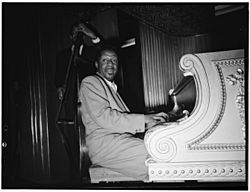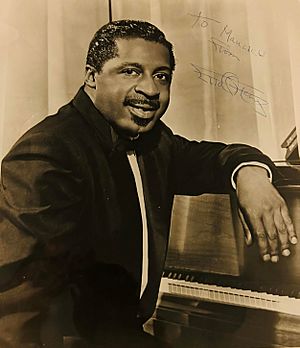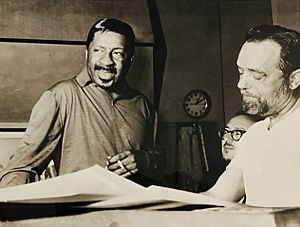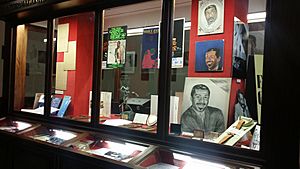Erroll Garner facts for kids
Quick facts for kids
Erroll Garner
|
|
|---|---|

c. 1947
|
|
| Background information | |
| Born | June 15, 1921 Pittsburgh, Pennsylvania, U.S. |
| Died | January 2, 1977 (aged 55) Los Angeles, California, U.S. |
| Genres | Jazz |
| Occupation(s) | Musician Composer |
| Instruments | Piano |
| Years active | 1944–1974 |
| Labels | |
Erroll Louis Garner (born June 15, 1921 – died January 2, 1977) was an American jazz pianist and composer. He was famous for his exciting "swing" style and beautiful slow songs, called ballads. His most famous song, "Misty", is a well-known jazz standard that many musicians still play today. It was first recorded in 1956 and was also a big part of the movie Play Misty for Me.
Music expert Scott Yanow called Erroll Garner "one of the most distinctive of all pianists" and a "brilliant virtuoso." He even has a star on the Hollywood Walk of Fame! His live album Concert by the Sea, released in 1955, sold over a million copies very quickly. This album made him a jazz legend.
Contents
Life and Career
Erroll Garner was born in Pittsburgh, Pennsylvania, on June 15, 1921. He was the youngest of six children and had a twin brother named Ernest. He went to George Westinghouse High School, just like other famous pianists Billy Strayhorn and Ahmad Jamal.
Starting His Piano Journey
Erroll Garner started playing the piano when he was only three years old! His older brothers and sisters had a piano teacher, and Erroll would listen and then play exactly what she had taught them. He taught himself to play by ear, meaning he never learned to read music. He just listened and played.
When he was seven, Erroll started playing on the radio in Pittsburgh with a group called the Candy Kids. By age 11, he was performing on riverboats along the Allegheny River. In 1937, he joined a local band led by saxophonist Leroy Brown.
In 1944, Garner moved to New York City. He played with famous musicians like bassist Slam Stewart and even Charlie Parker in 1947. Even though he couldn't read music, the Pittsburgh music union made him an honorary member in 1956 because of his amazing talent. Erroll had an incredible memory for music. After hearing a classical pianist perform, he could go home and play much of the music from memory!
Fighting for Artist Rights
In 1960, Erroll Garner sued Columbia Records. He had a special agreement that said Columbia needed his permission to release any of his music. But they released some songs without asking him. After three years, the court decided that Erroll was right. This was a very important decision for artists, helping them have more control over their own music. Columbia had to pay him money and take back the unauthorized records.
His Manager, Martha Glaser
From 1950 until he passed away in 1977, Erroll Garner's manager was Martha Glaser. She helped him with his career and fought for his rights.
His Passing
Erroll Garner passed away on January 2, 1977, from heart problems related to a lung condition. He is buried in Pittsburgh.
His Unique Playing Style
Erroll Garner was not very tall, about 5 feet 2 inches (157 cm). He often sat on several telephone directories (old phone books) to reach the piano keys comfortably! He was also known for humming and making sounds while he played, which you can hear on many of his recordings. He helped jazz musicians move from playing in small clubs to performing in big concert halls.
Scott Yanow called him "one of the most distinctive of all pianists." Erroll showed that a jazz musician could be very popular without changing their unique style. He was a "brilliant virtuoso who sounded unlike anyone else." He had an "orchestral approach," meaning his piano playing sounded like a whole orchestra.
His special style involved his right hand playing a little bit behind the beat, while his left hand kept a steady rhythm. This created a fun, carefree feeling and an exciting musical tension. He would sometimes speed up his right hand to catch up, which sounded like a "gas pedal" in a car. This unique way of playing was sometimes called the "Russian Dragon." He was also amazing at playing different rhythms with each hand at the same time.
Erroll often started his songs with playful and surprising introductions. Listeners never knew what song he was about to play!
Bassist Ray Brown called Garner "The Happy Man." Pianist Ross Tompkins said Garner's special sound came from his "happiness."
His Music and Legacy
Erroll Garner's first recordings were made in 1944. His career really took off in the late 1940s with songs like "Fine and Dandy" and "Summertime".
His 1955 live album, Concert by the Sea, was a huge success. It featured Eddie Calhoun on bass and Denzil Best on drums. This recording was made at a former school in California with simple equipment, but it became one of the best-selling jazz albums ever.
In 1954, Garner wrote "Misty." He recorded it in 1955 for his album Contrasts. Later, words were added to the song. "Misty" quickly became a jazz favorite and a signature song for singer Johnny Mathis. Many other famous singers like Ella Fitzgerald and Frank Sinatra also recorded it. The song was even used in Clint Eastwood's movie Play Misty for Me.
Other important albums include One World Concert (1963), Feeling Is Believing (1970), and Magician (1974). Sometimes, he added Latin percussion instruments like a conga drum to his trio.
In 1964, Erroll Garner appeared on a TV show in the UK called Jazz 625.
Since Erroll couldn't write music, he would record his ideas on tape. Later, other people would write them down for him.
New Discoveries and Archives
In 2012, a film about Garner called No One Can Hear You Read was released. This title came from something Erroll used to say when asked why he never learned to read music. The film showed him playing and speaking, and included interviews with fans like Woody Allen and fellow musicians. It reminded everyone how popular and original he was.
In 2015, the people managing Erroll Garner's legacy created the Erroll Garner Jazz Project. They gave a huge collection of his historical items, called the Erroll Garner Archive, to the University of Pittsburgh.
Many of his recordings have been re-released, including an expanded version of Concert by the Sea in 2015 with new songs. In 2016, an album called Ready Take One was released, featuring 14 songs that had never been heard before! In 2018, a live concert from 1964 called Nightconcert was released.
In 2021, Erroll Garner's music was even featured on a song called "All Night Parking" with the famous singer Adele on her album 30.
His Music Rights
In 2016, a company called Downtown Music Publishing started managing all of Erroll Garner's music, including "Misty." They also manage many of his original recordings, some of which have not yet been released.
Lost Recordings
Sadly, some of Erroll Garner's music was lost in the 2008 Universal fire.
Discography
Erroll Garner released many albums throughout his career. Here are some of his notable works:
- Serenade To Laura (1945–1949)
- Giants of the Piano (1947)
- Early in Paris (1948)
- Back To Back (1949)
- The Greatest Garner (1949–1950)
- Piano Moods (1950)
- Gems (1951)
- Solo Flight (1952)
- Plays for Dancing (1953)
- Erroll Garner (At the Piano) (1953)
- Gone With Garner (1954)
- Garnering (1954)
- Mambo Moves Garner (1954)
- Contrasts (1954)
- Erroll! (Erroll Garner In The Land Of Hi-Fi) (1954–1955)
- Plays Misty (1954–1955)
- Solitaire (1955)
- Afternoon of an Elf (1955)
- Gone Garner Gonest (1955)
- Music for Tired Lovers (1955)
- Concert by the Sea (1955)
- Garnerland (1955)
- He's Here! He's Gone! He's Garner! (1956)
- After Midnight (1956)
- The Most Happy Piano (1957)
- Other Voices (1957)
- Soliloquy (1957)
- Encores in Hi-Fi (1958)
- Paris Impressions, Vol. 1 (1958)
- Paris Impressions, Vol. 2 (1958)
- The One and Only Erroll Garner (1960)
- Swinging Solos (1960)
- The Provocative Erroll Garner (1961)
- Dreamstreet (1961)
- Closeup in Swing (1961)
- Informal Piano Improvisations (1962)
- One World Concert (1963)
- A New Kind of Love (1963)
- Mr. Erroll Garner and the Maxwell Davis Trio (1964)
- Serenade in Blue (1964)
- Amsterdam Concert (1964)
- Erroll Garner Plays (1965)
- Now Playing: A Night at the Movies (1965)
- Campus Concert (1966)
- That's My Kick (1967)
- Up in Erroll's Room (1968)
- Feeling is Believing (1970)
- Gemini (1972)
- Magician (1974)
- Play it Again, Erroll! (1975)
- The Elf: The Savoy Sessions (1976)
- Erroll Garner Plays Gershwin & Kern (1976)
- Yesterdays (1978)
- Long Ago and Far Away (1987)
- Body & Soul (1991)
- Erroll Garner's Finest Hour (2003)
- The Complete Concert by the Sea (2015)
- The Real...Erroll Garner (The Ultimate Collection) (2016)
- Ready Take One (2016)
- Nightconcert (2018)
- “All Night Parking” (2021) with Adele
Personal Life
Erroll Garner did not marry. He had a daughter named Kim Garner, who was interviewed in the film No One Can Hear You Read.
Images for kids
See also
 In Spanish: Erroll Garner para niños
In Spanish: Erroll Garner para niños





